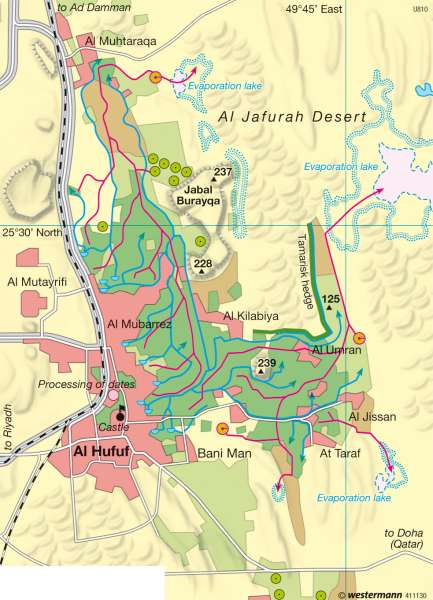Al Hasa — Oasis
Persian Gulf region
978-3-14-100790-9 | Page 104 | Ill. 1

Information
Of the vast land area of Saudi Arabia, which covers some 2 million square kilometres, only about 1 percent can be used for agriculture; the rest is mainly desert. Settlements and agriculture are therefore dependent on the availability of oases with their accessible water reserves. Al Hasa, in Saudi Arabia's Gulf region (Eastern Province) on the 25th parallel north, is one of the largest and oldest oases in the Middle East, and its settlement and use goes back to antiquity.Climate and Utilization
The oasis, situated about 100 kilometres from the Gulf coast, consists of numerous small towns and communities with their main centres at Al Hufuf and Al Mubarraz. Today it is home to some 650,000 people. Alongside the oil industry, the main economic activity is agriculture, in which the date palm plays an important role.
The soils of the oasis are thin and may hold high proportions of loam and clay. They are often covered by layers of sand. The supply of water is based on numerous water-bearing soil formations. The water rises to the surface from some 30 artesian wells. However the level of the groundwater has fallen dramatically in recent years, so that the valuable liquid must be pumped out from ever greater depths.
A transitional subtropical-tropical climate prevails in the region. Temperature fluctuations are substantial, both during the day and between the seasons. The average temperature in December is 15 °C, but in August it is over 30 °C. In summer it is not unusual to reach 50 °C at ground level.
Annual rainfall is just 70 millimetres, and it falls in winter. Due to the intensive radiation from the sun, the potential evaporation (= water deficit) is 3,470 millimetres!
Date palms are the most important regular item of cultivation in the oasis; there are currently said to be some 2.5 million trees in Al Hasa. In addition, various citrus fruits are grown such as oranges and limes as well as jujube, a salt-resistant fruit variety from India. Agricultural crops include mainly rice, fodder crops such as alfalfa and, in recent times, increasingly also vegetables and wheat. Of great importance today, alongside date processing, is also milk production and the production of mutton, beef and poultry meat.
Advantages and Risks
The extensive irrigation and drainage facilities were planned and constructed in the 1960s and 1970s with German participation. Today the pumps provide some 200 million cubic metres of water per year to irrigate an area of 16,000 hectares. The water is made available to the farmers free of charge. The irrigation and drainage canals have a length of some 1,500 kilometres. The drainage canals flow into evaporation lakes that were laid out on the eastern edge of the oasis in former dry river beds, so-called wadis. Without drainage, the water from the wells would not be able to run off and the consequence would be the development of swamps and rapid salinization of the soil. Dense stands of common reed (Phragmites communis) have spread along the canals and lakes, and the lake regions, which are rich in bird life, are now popular hunting grounds.
The numerous date palm plantations also offer urban dwellers recreation possibilities and the chance to escape from the overheated cities in summer. Many house-owners rent out their properties for weekend stays and family vacations. Also worthy of note is the old fort in Al Hufuf, built of loam and still in a state of complete preservation.
As protection against the advancing desertification caused by the spread of shifting sand dunes, the areas at the edge of the oasis between Al Kilabiya and Al Umran have been planted with tamarisk, a highly drought and salt resistant variety of tree. The railway track and a number of roads were protected in the 1970s by spraying crude oil along their verges to prevent them from being covered by sand. The railway line from Riyadh to Dammam, which can be recognized on the map, is the only one in the country.
On account of its intensive utilization, the level of the groundwater has been falling continuously for some years. The falling supply of water creates increasing problems for agricultural production. Some areas of cultivation have already had to be abandoned because of the advancing salinization of the soil. The reasons for the higher proportions of sodium and calcium salts in particular are the increasing salt content of the well water and the use of out-of-date irrigation methods such as traditional damming procedures.
Various efforts are therefore being made by King Faisal University and the National Date Palm Research Center in Al Hufuf to demonstrate the possibilities for saving water in plant production. This includes for example the use of modern irrigation techniques such as circular sprinklers, or micro or drip irrigation.
G. Ebert; Ü: J. Attfield




